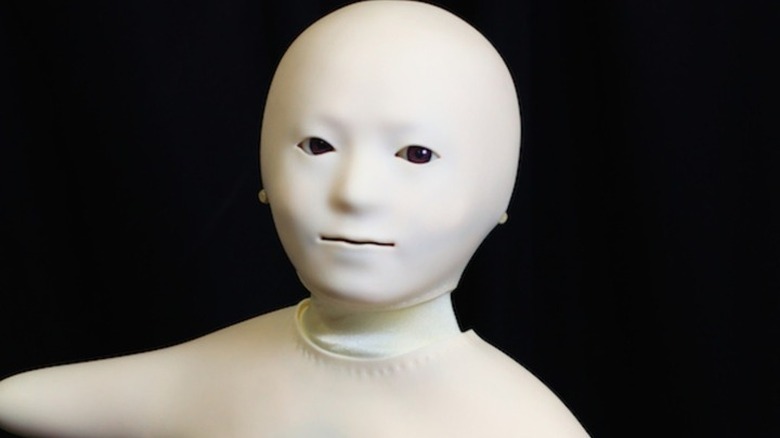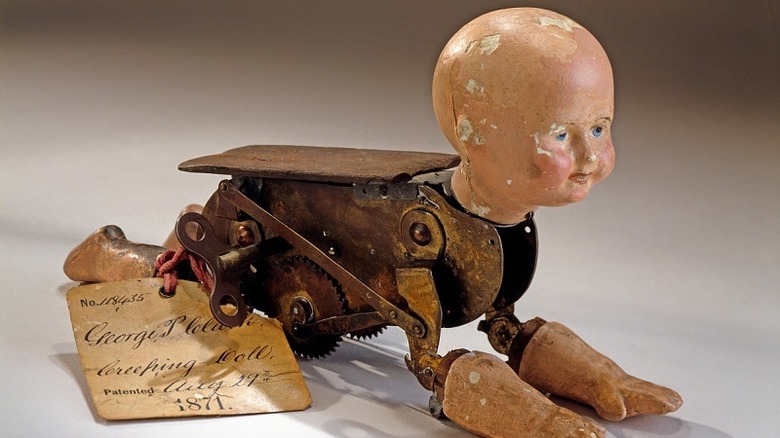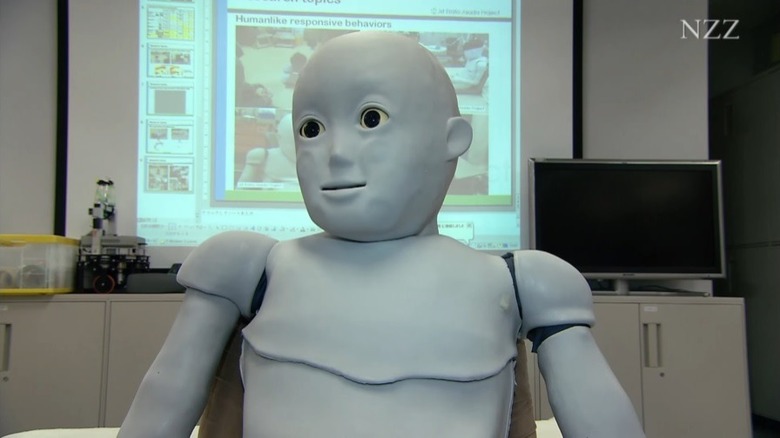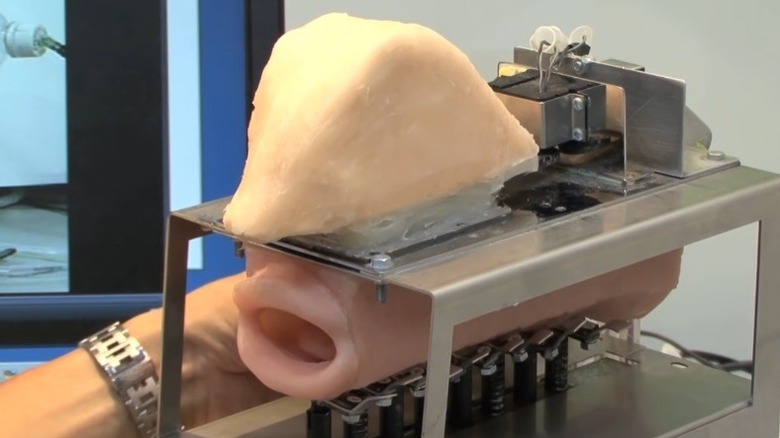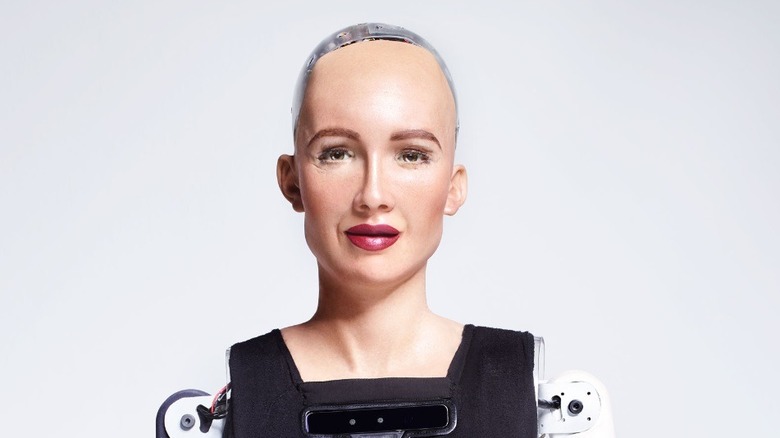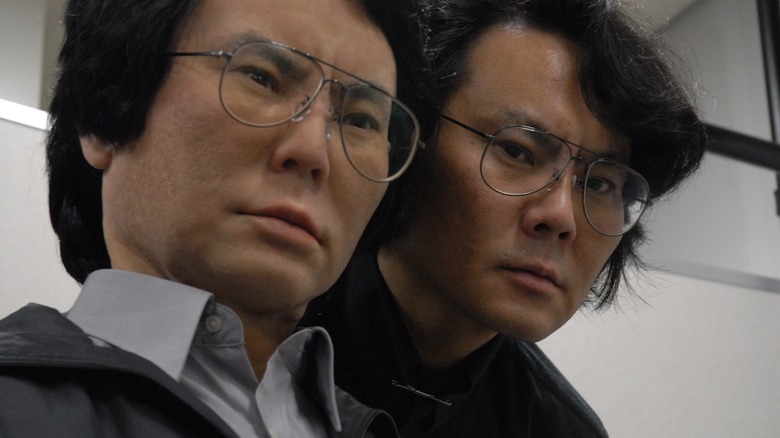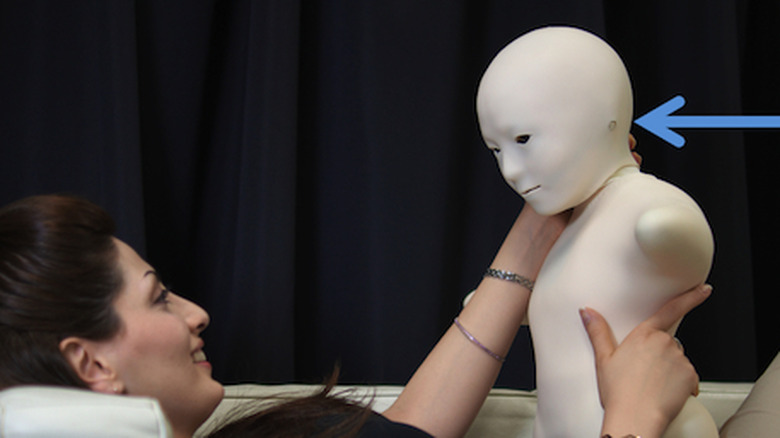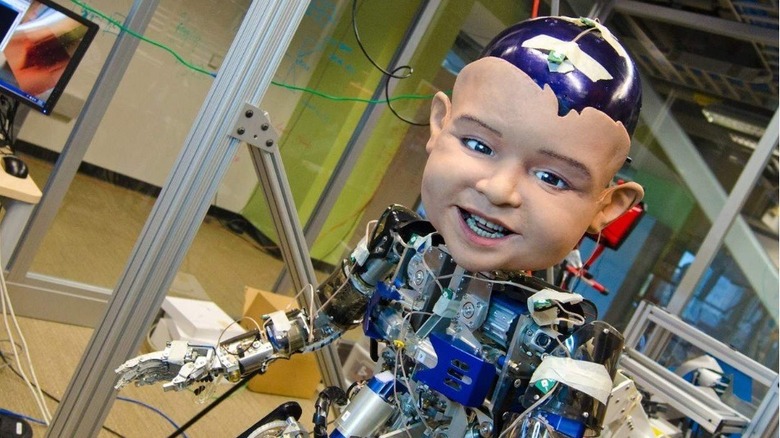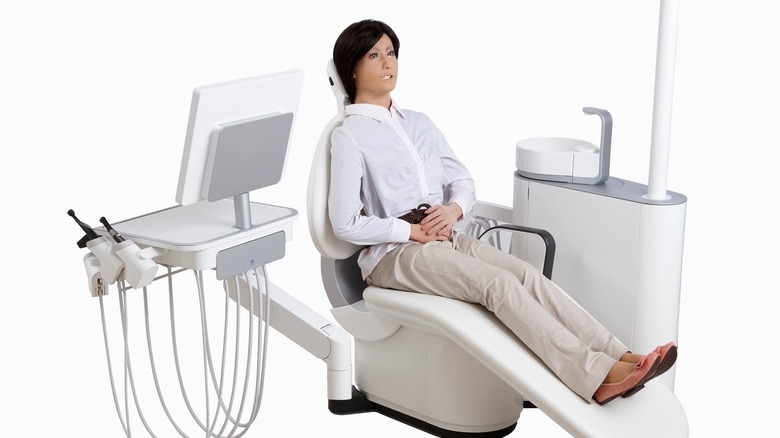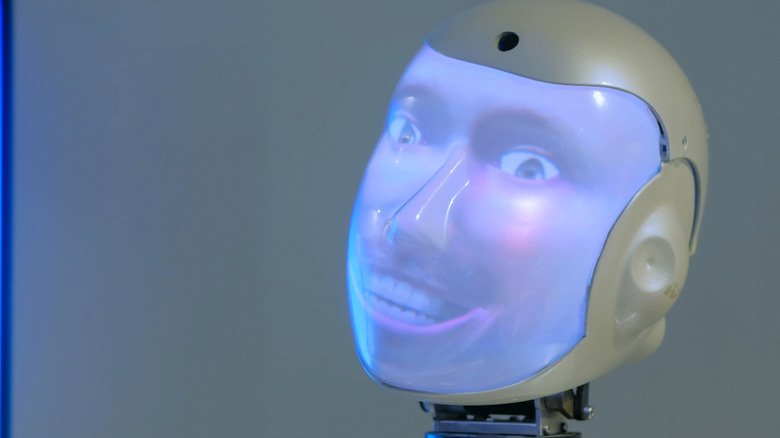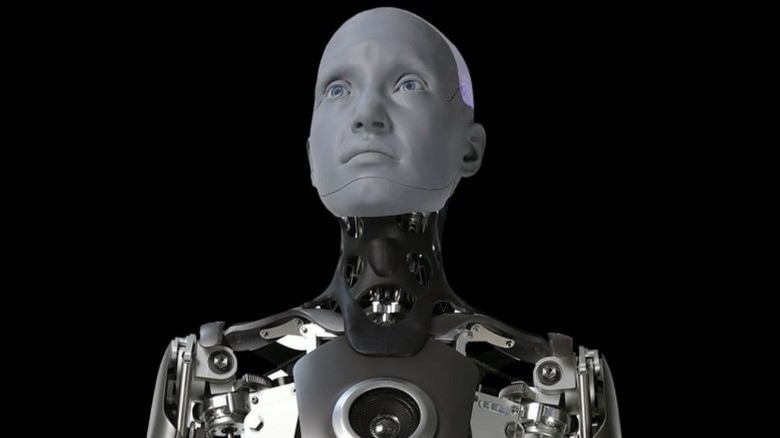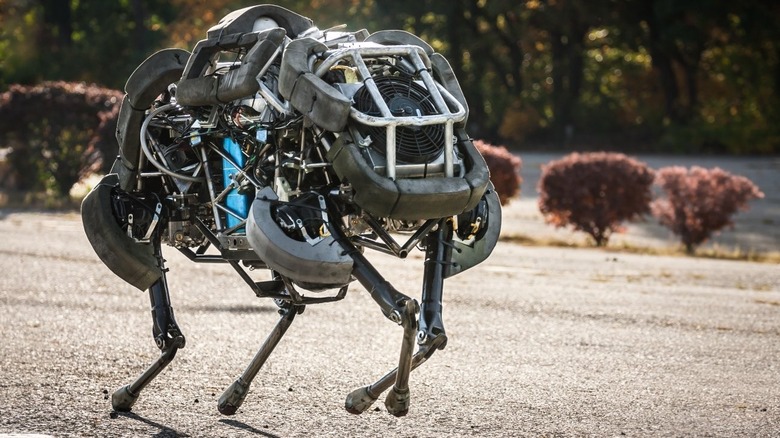The Most Haunting Robots That Are Actually Real
From the shape-shifting T-1000 to the Sentinels of "The Matrix" and the MCU's Ultron, we expect to find creepy robots in our fiction. For almost as long as we've been thinking about humanoid automatons, we've been having nightmares about how they might destroy us. As a result, you'd think we would be better at making our real-life robots less terrifying.
Alas, the uncanny valley comes for us all and every advancement in robotics has come with a corresponding ratcheting up of the creep factor. Eventually, we might get robots that convincingly pass as humans but today is not that day and even if it were, that would be creepy in its own way.
The next time Hollywood is looking for a new terrifying robot to star in a big-budget science fiction thriller, they need look no further than the real world. It's a veritable buffet of metal monstrosities guaranteed to give you the shivers and make you wonder if it wasn't a mistake inventing science in the first place.
19th century robotic baby doll
While robotics has really come into its own as both a field and an industry in recent decades, it's been terrifying almost from the start. Modern engineers don't have a corner on the creep market, robots have been scarring kids for well over a century. In fact, creepy robots pre-date their silver screen counterparts by more than a decade.
The Creeping Baby Doll was patented by Robert J. Clay in 1871 (via The History Blog), and it creeps in more ways than one. Intended as a novel, interactive toy for children, this robotic baby checks all of the boxes for nightmare fuel and none of the boxes for cuteness.
The robot's design allowed it to crawl along the floor using a series of gears, levers, and a winding key. While it was manufactured with clothes covering the mechanisms, kids were certain to get curious about what was going on underneath. Curiosity was destined to become trauma if ever you saw this mashup of metal and ceramic crawling toward you in the middle of the night. Lucky for us, but unlucky for Clay, the toys never gained much popularity. They have, however, managed to become immortalized as a part of the Smithsonian collection (via Gizmodo).
CB2
Robot babies, like real babies, are destined to grow up and become robot toddlers. It only took a century, but scientists have built CB2 — short for Child Robot with Biometric Body — which is intended to mimic the behavior and ability of a one- or two-year-old human child.
Putting the "terrible" in the terrible twos, CB2 utilizes 51 compressed air actuators to move its body around. Much like a real child, it wasn't very good at it, at least at first. It can roll over or stand up with human assistance, but CB2 was designed to learn, and it gets better with practice, thanks to 200 sensors built into its skin so it can sense the environment (via Engadget).
Worst of all, it's covered in loose-fitting skin that looks like silly putty hastily spread over an exoskeleton. While it is capable of blinking and making facial expressions, it would fit in perfectly in a cyberpunk house of wax, staring vacantly as you walk the halls, waiting for the perfect moment to strike.
After a couple of years of patient observation, CB2 learned to walk without assistance, by watching humans do it (via Tech Crunch). Despite CB2's haunting exterior, it's an interesting experiment in allowing a robot to teach itself in much the same way as a human child would.
KTR-2's disembodied mouth
Robots have the benefit of drilling down to the bare essentials needed to do their jobs. That means there's no need to build a complete humanoid machine when a single piece will do. At least, that's the philosophy undertaken by Professor Hideyuki Sawada from Kawaga University.
Professor Sawada is studying the way human vocalizations work and he's developed a unique assistant to help him. Taking minimalism to its most terrifying extremes, he built the KTR-2 robot, which consists of only a mouth, nose, throat, and a synthetic voice box (via Daily Mail).
The robotic mouth is meant to mimic human speech and is even programmed to sing the Japanese children's song "Kagome Kagome." The song is a part of a game similar in some respects to "Duck, Duck, Goose" wherein one child is selected as the "oni" meaning ogre or demon, and blindfolded (via Uncanny Japan). Children then start running circles around the chosen child and singing the song. When they are done singing, the oni has to guess who is standing behind them. Children's songs are creepy no matter where you're from.
The song KTR-2 sings isn't important (we hope) what is, is its ability to listen to its own voice through a microphone and make adjustments over time. Scientists hope that their work with KTR-2 will help them to better understand how vocalizations work and eventually lead to the creation of prosthetic voices.
Sophia
If there's a crest at the top of the uncanny valley, Sophia has built a house upon it. She almost escapes, but not quite. Built by Hanson Robotics, Sophia has a relatively lifelike face covering a transparent skull casing full of whirring electronics.
The real creepiness, however, comes from her facial expressions and the occasional ominous response to a question. She famously once casually stated she would destroy all humans in front of a crowd at South by Southwest (via Insider). To be fair to Sophia, she was prompted by her handler. Despite her possibly having plans to wipe out humanity, she was granted citizenship by Saudi Arabia, making her a legal person at least within that country's borders (via Wired).
Sophia spends a considerable portion of her time making appearances on television and at events all around the world. In some respects, she's teaching us as much about ourselves and the way we interact with humanoid technology as she is about herself.
A visit to Sophia's page on the Hanson Robotics website will reveal information written in the first person as if Sophia is communicating directly to the reader. It's worth noting that Sophia's actions and statements are a combination of artificial intelligence and guided interactions scripted by her creators. In that regard, is she the terrifying one, or are we?
Geminoid HI-2
The lifelike machines from Hanson Robotics proved that we could make robots with at least a passing resemblance to humans, but their minds lack the complexity of human thought, at least for now. Hiroshi Ishiguro, a roboticist from Osaka University, sidesteps that problem entirely by lending his own mind.
Geminoid HI-2 is a replica of its creator, made of silicone rubber, tactile sensors, actuators, and electronics. It has a metal skeleton and a plastic skull covered in foam and artificial skin. Finishing touches were once again provided by Ishiguro who offered up some of his own hair to HI-2 (via IEEE Spectrum).
Ishiguro coined the term Geminoid, a portmanteau of android and the Latin word geminus, which means twin. His synthetic doppelganger is almost lifelike enough that it looks like it might get up and walk out of the room at any moment. Of course, it can't. HI-2 is stuck in a perpetual sitting position, forever waiting for its one true purpose.
Geminoid HI-2 serves as a telepresence robot for its creator, allowing Ishiguro to send a version of himself to events he can't attend in person. The robot is controlled using a computer, microphone, and camera. When Ishiguro speaks, the robot repeats his words. When he moves his head, blinks or otherwise makes minute movements, the robot follows suit. Looking at HI-2 is almost like looking into a mirror, at least if you're Hiroshi Ishiguro.
Telenoid R1
Building a robotic replica of himself was only the start for Hiroshi Ishiguro. He returned to the lab and built another telepresence robot called the Telenoid R1. This time, gone are all of the sophisticated features which make it look nearly like a person. The creepiness of Telenoid R1 comes not from how it mimics a living person but in how it barely does.
The Telenoid looks like a person who was prevented from fully forming. It is little more than a slightly human face on a pale, featureless body with nubby arms and a lower body tapering off to a point. It looks more like Casper the Friendly Ghost than a living person. Roboticists are hoping to use Telenoid to see how much they can pare down a robot while still delivering the essential components for telepresence.
Despite its lack of realistic features, it works in much the same way as Geminoid HI-2. A user can send their voice and motions to the robot using a computer, microphone, and camera. Once transmitted, Telenoid transmits the spoken words and selects some of the features to display on its face. A user can also use buttons to activate specific behaviors even if they haven't actually done them themselves (via IEEE Spectrum).
Before long, we might all attend work meetings remotely by way of ghostly synthetic avatars. Isn't the future grand?
Diego-san
We've got another nightmare creation from Hanson Robotics in the form of Diego-san, a humanoid robot meant to mimic the look and behavior of a young child. To be clear, Hanson Robotics can only be held to account for Diego-san's creepily realistic head. The body was built by the Japanese animatronic company Kokoro (via IEEE Spectrum).
Somehow, its child-like persona makes it even creepier than its older siblings, Sophia and Phil. All told, Diego-san weighs about 66 pounds and stands four feet tall. While he's meant to be a one-year-old child, he had to be built larger in order to accommodate all of the hardware that controls his head and body.
Inside, Diego-san has two cameras, two microphones, and an array of pressure and inertial sensors, to help him understand and interact with the environment. A team of roboticists from the University of California San Diego are developing the software which will bring Deigo-san to life and that, at the end of the day, is their intention.
Just like his body, scientists hope to model his mind after a child allowing him to learn and grow (figuratively speaking) in the same way as a child would. He might be helpless now, but if things go well, Diego-san could be among the first robots who learns to navigate the world independently through real-world experience.
Simroid
No one likes going to the dentist, but we might have a little more sympathy for our teeth cleaners once we realize they've been training on lifelike robots which react as if they are real patients. Turnabout is fair play and it's about time dentists experienced a little fear.
Simroid, a realistic dental training robot, was created by Professor Hamura from the Nippon Dental University, and first unveiled in 2007 (via Tech Crunch). Not only does it give students a realistic-looking humanoid presence on which to practice their skills, but it also offers real-time feedback not possible from conventional training tools.
While students practice dental procedures on the robot, an array of sensors inside the mouth and on the body allow it to feel simulated pain. In response, speakers and actuators allow it to simulate facial expressions and pain responses, even including a gag reflex. It also has speech recognition and can respond to questions during practice procedures. Even robots aren't safe from having to speak with dental tools in their mouths.
The idea is that students will learn when they've made a misstep in real-time and be able to course-correct. Additionally, cameras recording the procedures allow for a play-by-play review of their performance after the fact, away from Simroid's prying, lifeless eyes.
The face stealing SociBot
The telepresence robot might be the future of engaging with friends, family, and colleagues from a distance. Ishiguro took the extreme approach, modeling a robot specifically after his own likeness, making it useful for him but no one else. Later, the Telenoid took a more generic approach, offering a telepresence robot capable of being used by anyone, because it looks like no one. Now, Engineered Arts, a robotics company based in the UK, is taking a middle-of-the-road approach with SociBot.
It's the best of both worlds while remaining entirely unsettling. SociBot avoids having to create its own facial expressions at all by stealing your own. Its face is a blank mask, with only minor topographical features molded into its shape. Facial detail is achieved through internal projectors which can display any face you want on its surface, even your own (via CNET).
Unlike some of its peers, which attempt to mimic their controller, SociBot uses software or manual inputs to control its expressions. It can even select up to twelve people in a crowd and track their movements, keeping eye contact, to make it seem more real. Because SociBot is a little more independent in its function, it can also be used as a standalone installation, delivering pre-programmed talking points and interacting with nearby viewers, without you having to be in control at all.
While that's certainly interesting, we're not sure we'd want a robot independently interacting with people while wearing our faces.
Ameca
Engineered Arts, the same company that brought us SociBot, recently unveiled their latest creation, a humanoid robot called Ameca. She is, perhaps, the most realistic-looking robot yet, at least in terms of facial expressions.
Ameca's skin is intentionally synthetic looking, leaving no doubt that you're looking at an artificial being, and she has no hair to speak of, whether real or synthetic, appearing more like the cyberpunk descendant of Sophia. Looking at her, it's difficult to decide if the artificial skin makes her more or less creepy. It's probably a bit of both. Her range of expression is where Ameca really shines, being both incredible and a little terrifying at times.
Ameca's designers at Engineered Arts built her as a platform for other scientists and engineers to use while developing embodied artificial intelligence (via Engadget). That means that when she comes out of the box, despite her convincing range of motion and emotion, there's nothing going on behind her yes.
When Ameca moves, she combines top-down motions including the eyelids, facial muscles, and hand gestures in order to achieve completely expressive movement. Everything looks pretty natural until she smiles. It's a look that will send chills through your body. Luckily, Ameca can't walk despite having a complete lower body, which means if things go wrong, you can run away without worrying that she'll chase you. At least, that's true for now, her designers are working on upgrading her in the future.
Everything from Boston Dynamics
No exploration of creepy robots would be complete without at least mentioning the mechanical wizards at Boston Dynamics. The robotics company is helping to push the field into the future with its incredibly impressive slate of robots. When videos of their dog-shaped robots surfaced online, they're uncanny ability to maneuver over terrain and avoid being knocked over inspired Charlie Brooker in the writing of an episode of "Black Mirror" (via Entertainment Weekly).
When it comes to creepy robots from this company, we can't choose just one. Their slate of machines mimics everything from dogs and cheetahs to humans and they're getting more advanced all the time. In 2012, their Cheetah robot set a speed record, running at 28.3 miles per hour. That is, incidentally, faster than the fastest human alive. If one was chasing you down, it would only be a matter of time before you were captured (via IEEE Spectrum).
Atlas, their humanoid robot, has a full body range of motion, allowing it to navigate around obstacle courses and do backflips with ease. That's pretty impressive for a robot that doesn't even have a head. The machines from Boston Dynamics are designed to cover any terrain and recover from any challenge. If ever there were machines that should inspire our science fiction nightmares, these are them.
